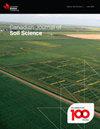针对 WUSN 信号衰减特性的自调整参数模型
IF 1.5
4区 农林科学
Q4 SOIL SCIENCE
引用次数: 0
摘要
无线地下传感器网络(WUSN)正逐步应用于智慧农业的土壤信息采集和作物生长环境监测。WUSN 可以避免农田耕作和其他机械作业活动带来的不便,获取地下土壤环境中的多层次、多维度参数,对农作物的土壤水分监测至关重要。然而,WUSN 在田间还没有普遍适用的传输协议标准。因此,研究不同土壤成分对无线传感器网络节点摆放的影响,可以为获取农田土壤水分信息提供科学指导,对精准农业的发展具有重要意义。本文设计了一种低功耗无线传感器网络节点,基于修正的弗里西亚传输模型和复折射率菲涅尔模型,提出了一种自适应优化模型,并提出了一种改进的遗传算法,根据土壤和距离因素自动调整融合参数,使不同土壤成分下的信号衰减预测更加准确。我们将自适应优化模型用于信号预测,与改进的弗里斯预测模型和复折射率菲涅尔预测模型进行了比较,结果表明,所提出的带有自动参数的自适应优化模型便于预测信号衰减,自适应优化模型使预测误差保持在非常低的水平。为了与土壤环境中的其他传感器进行比较,测试了自适应模型预测的分布式光纤温度传感器的温度。结果表明,自适应模型比分布式光纤温度传感器更有利于预测 WUSN 中的信号衰减。本文章由计算机程序翻译,如有差异,请以英文原文为准。
A Self-adjusting Parametric Model for Attenuation Characteristics of WUSN Signal
Wireless Underground Sensor Network (WUSN) is gradually applied to smart agriculture for soil information collection and monitoring of crop growth environment. WUSN can avoid the inconvenience caused by tillage and other machine operation activities on farmland, and obtains multi-level and multi-dimensional parameters in the underground soil environment, which is crucial for soil moisture monitoring of crops. However, WUSN has no universally applicable transmission protocol standards in the field. Therefore, the research of different soil compositions on the placement of wireless sensor network nodes can provide scientific guidance to obtain soil moisture information of agricultural fields, it is important for the development of precision agriculture. In this paper, a low-power WUSN nodes was designed, based on modified Frisian transmission model and the complex refractive index Fresnel model, we proposed an adaptive optimization model, and also proposed an improved Genetic Algorithm, which is automatically adjust fusion parameter according to soil and distance factors, it made the prediction of signal attenuation under different soil components more accurately. We used the adaptive optimized model for signal prediction, comparing with the modified Friis prediction model and the complex refractive index Fresnel prediction model, the results shown that the proposed adaptive optimization model with automatic parameter is convenient to predict the signal attenuation, the adaptive optimization model made the prediction error stay really low. In order to compare with other sensors in the soil environment, the temperature of the distributed fiber optic temperature sensor was tested, which predicted by the adaptive model. The result shown that the adaptive model is more favorable to the prediction of signal attenuation in WUSN than distributed fiber optic temperature sensors.
求助全文
通过发布文献求助,成功后即可免费获取论文全文。
去求助
来源期刊

Canadian Journal of Soil Science
农林科学-土壤科学
CiteScore
2.90
自引率
11.80%
发文量
73
审稿时长
6.0 months
期刊介绍:
The Canadian Journal of Soil Science is an international peer-reviewed journal published in cooperation with the Canadian Society of Soil Science. The journal publishes original research on the use, management, structure and development of soils and draws from the disciplines of soil science, agrometeorology, ecology, agricultural engineering, environmental science, hydrology, forestry, geology, geography and climatology. Research is published in a number of topic sections including: agrometeorology; ecology, biological processes and plant interactions; composition and chemical processes; physical processes and interfaces; genesis, landscape processes and relationships; contamination and environmental stewardship; and management for agricultural, forestry and urban uses.
 求助内容:
求助内容: 应助结果提醒方式:
应助结果提醒方式:


